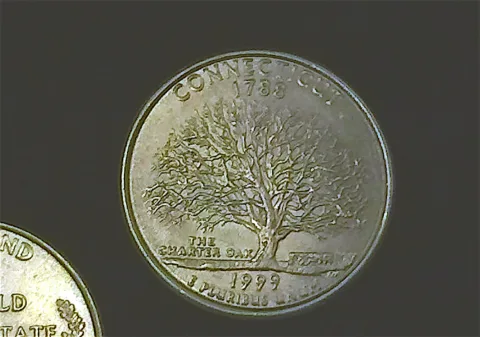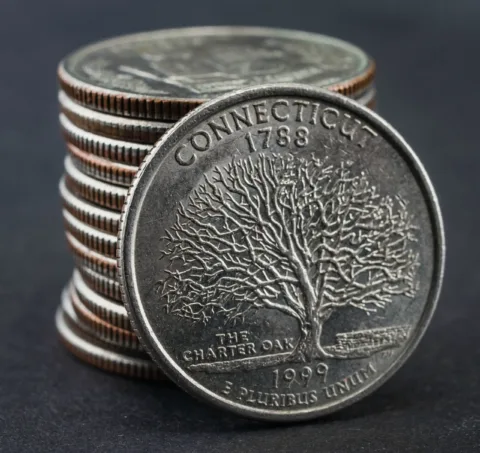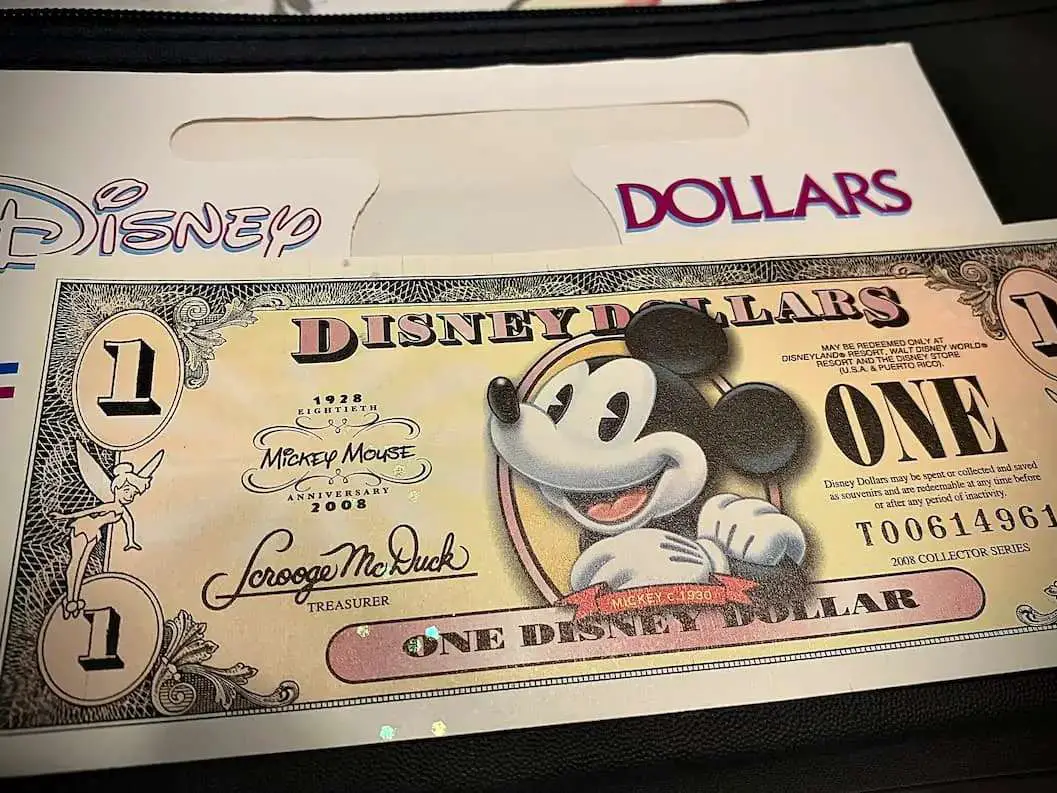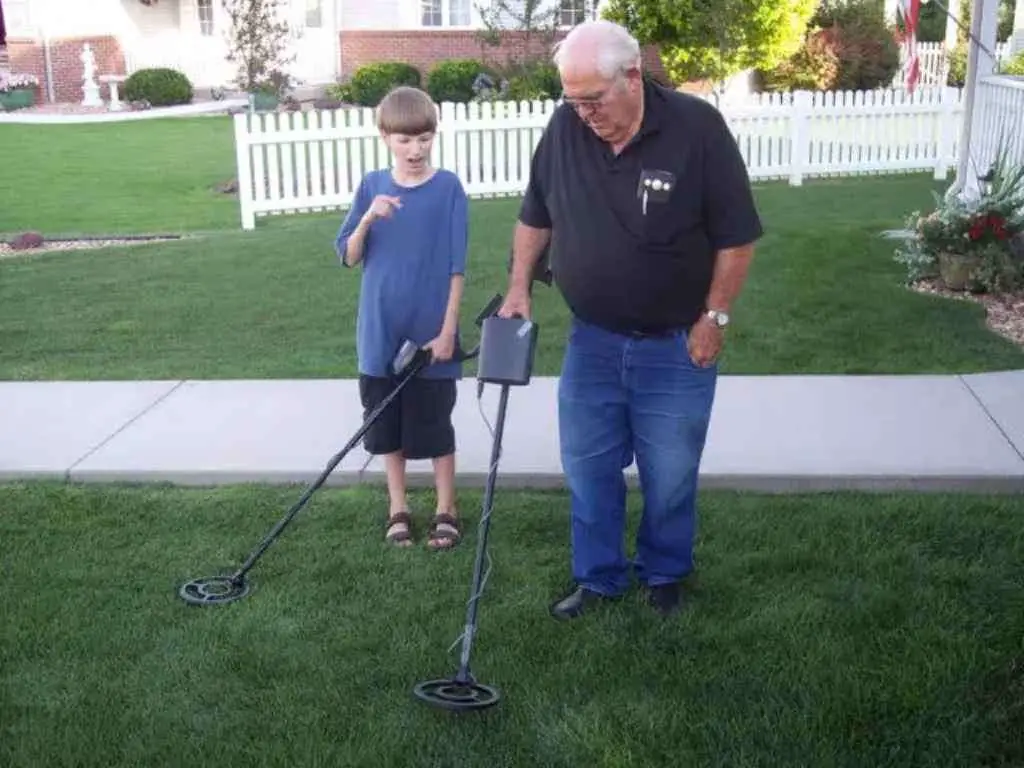
Have you found a Connecticut state quarter and want to know what it’s worth? Perhaps you even have a 1999 Connecticut quarter that has an error.
Believe it or not, many 1999 Connecticut state quarters are worth far more than their 25-cent face value. Some 1999 State Quarters are even worth hundreds or thousands of dollars — no joke!
So… which Connecticut quarters are worth the big bucks? And which ones are worth just 25 cents?
In this article you will find:
- The most valuable Connecticut state quarters
- Which 1999 Connecticut error quarters you should be looking for
- How many Connecticut quarters were made
- Other fun facts about the Connecticut state quarter
What’s The Most Valuable 1999 Connecticut Quarter Error?
There’s one type of Connecticut quarter error worth as much as $10,000!
Apparently, a few of the 50 State Quarters from 1999 were struck on the planchets (coin blanks) designed for the Sacagawea dollar. These “experimental quarters” are quite rare — only a few were made representing each state (Delaware, Pennsylvania, New Jersey, Georgia, Connecticut) from the first year of the 50 State Quarters series.
These are super rare and super valuable experimental planchet errors!
So… how can you tell if you’ve got a rare Connecticut quarter error struck on a Sacagawea dollar planchet or an ordinary quarter with gold toning?
How to tell if you’ve got the rare Connecticut quarter error:
- Weight — This Connecticut error quarter registers between 5.9 and 6.3 grams in weight — much heavier than the normal 5.67-gram weight for a regular copper-nickel clad Connecticut state quarter. (See my favorite coin scale.)
- Thickness — Does your quarter look thicker than normal? A 1999 error quarter looks thicker.
- Color — The Connecticut error coin will appear gold, or even greenish in color. What color does your Connecticut quarter appear to be?
- Edge — The 1999 Connecticut quarter error doesn’t contain any edge reeding (those vertical lines on the edge of a normal quarter) — this quarter has a smooth edge.
If any of your 1999 Connecticut state quarters seem to match the characteristics listed above, then it’s worth having it checked out by a numismatic professional. You can take your coin to a reputable coin dealer or have it certified by a third-party coin-grading company.
Other Types Of Connecticut Quarter Errors
Have you had a hard time finding any of the 1999 Connecticut state quarters struck on wrong-metal planchets, mentioned above?
No worries… There are many other kinds of errors to look for on your Connecticut state quarters!
Here are 3 of the most popular types of Connecticut quarter errors you should be looking for:
#1 – Doubled die Connecticut quarters
At this point, there aren’t too many doubled dies for the Connecticut state quarter known to exist — but there’s at least one out there! It involves doubling in the branches of the Charter Oak on the reverse (tails side) of Philadelphia-minted coins. Values range all over the board, but pieces like this commonly trade for around $10 to $25 apiece.
#2 – Off-center Connecticut quarters
These are really cool errors that show the coin struck partially off-center. The more off center the strike, the more this Connecticut quarter error is worth. A Connecticut state quarter that is minimally off-center, say by 5% or 10%, may trade for $25 to $50. But if you find a drastically off-center specimen with more than half of the design missing and the date still showing… a piece like that can bring hundreds of dollars!
#3 – Connecticut quarters with die chips & die breaks
Some coins have unintended, raised blobs of metal on the surface. These are caused by areas of damage to the die (the device that strikes an image onto a blank coin) and are known as die chips, die breaks, and die cuds.
- Connecticut state quarters with die chips (or tiny die breaks) can range in value from $3 to $10 apiece — sometimes more.
- Find a die break that appears as a long line running across the surface of the coin? These errors can bring more than $100.
- And a 1999 Connecticut state quarter with a large die cud can inspire intense bidding among error coin specialists and go into the hundreds of dollars!
How Much Is A Regular 1999 Connecticut Quarter Without Errors Worth?

We all want to find rare and valuable errors in our pocket change, but most likely you’ll wind up finding a bunch of Connecticut state quarters without errors. So, are they worth only face value?
For the most part, yes. A regular 1999 Connecticut state quarter from the Philadelphia Mint (P mintmark) or Denver Mint (D mintmark) that is worn and has no errors is worth only its face value of 25 cents.
However, there is some extra value for Connecticut quarters that have never been spent as money:
- Uncirculated 1999-P and 1999-D quarters are worth 50 cents and up
- Proof Connecticut quarters (those struck only for collectors) are also worth more than face value:
- Copper-nickel 1999-S Connecticut quarters are worth about $1.50 to $3 each
- 90% silver 1999-S Connecticut quarters are worth about $4+ each
How Many 1999 Connecticut Quarters Were Made?
In a nutshell? LOTS! More than 1 billion were struck.
But you came here looking for a more precise mintage figure, didn’t you?
Here’s how many Connecticut state quarters were made:
- 1999-P quarter: 657,880,000 minted
- 1999-D quarter: 688,744,000 minted
- 1999-S copper-nickel clad proof quarter: 3,713,359 minted
- 1999-S silver proof quarter: 804,565 minted
So… 1999 Connecticut state quarters aren’t rare coins. But if you find a super-nice one, or one with an error, you may have hit the jackpot!
Fun Facts About Connecticut And Its State Quarter
There’s so much interesting trivia about the quarters that pay homage to “The Constitution State.”
Here are a few cool facts about the 1999 Connecticut quarter and the New England state it honors:
- John Flanagan designed the portrait of George Washington depicted on the obverse (heads side) of the Washington quarter beginning in 1932. Sculptor-engraver William Cousins modified the Washington bust design in 1999 to help make more space on the coin for the various designs in the 50 State Quarter series.
- T. James Ferrell designed the motif featuring the Charter Oak — a large tree that dated to perhaps the 12th century and sadly fell during a storm in 1856. Legend says Connecticut’s Royal Charter of 1662 was tucked away inside the hollow of the tree to hide it from the English governor-general. Over the centuries, the tree became symbolic of American independence. In addition to its appearance on the 1999 Connecticut state quarter, the Charter Oak is also found on the 1935 Connecticut Tercentennial half dollar.
- Connecticut was the 5th state to join the Union. It ratified the U.S. Constitution on January 9, 1788.
- Connecticut’s nickname, “The Constitution State,” is derived from the first constitution of Connecticut — drafted 1638-39 and known as “The Fundamental Orders.” Many say “The Fundamental Orders” inspired the drafting of the Constitution of the United States in the 1780s.
- You probably already know the official Connecticut state song… It’s “Yankee Doodle Dandy!”
More Rare and Valuable Quarters
I’m the Coin Editor here at TheFunTimesGuide. My love for coins began when I was 11 years old. I primarily collect and study U.S. coins produced during the 20th century.
I’m a member of the American Numismatic Association (ANA) and the Numismatic Literary Guild (NLG) and have won multiple awards from the NLG for my work as a coin journalist. I’m also the editor at the Florida United Numismatists Club (FUN Topics magazine), and author of Images of America: The United States Mint in Philadelphia (a book that explores the colorful history of the Philadelphia Mint). I’ve contributed hundreds of articles for various coin publications including COINage, The Numismatist, Numismatic News, Coin Dealer Newsletter, Coin Values, and CoinWeek.
I’ve authored nearly 1,000 articles here at The Fun Times Guide to Coins (many of them with over 50K shares), and I welcome your coin questions in the comments below!





